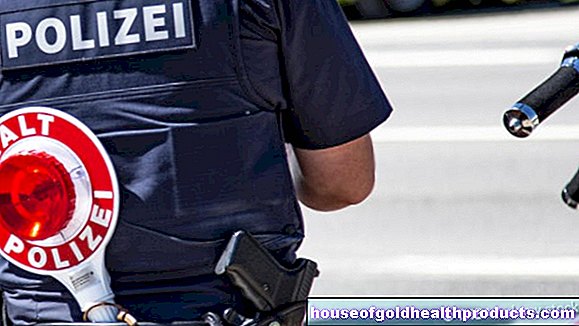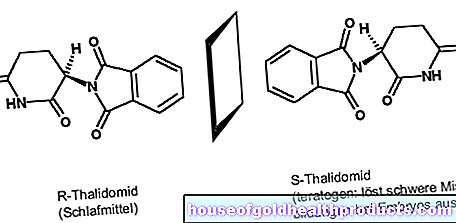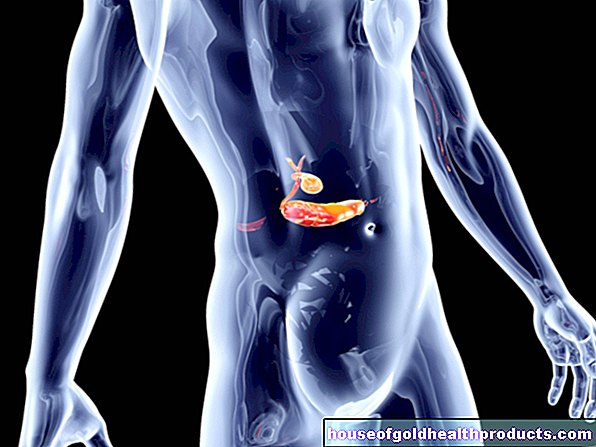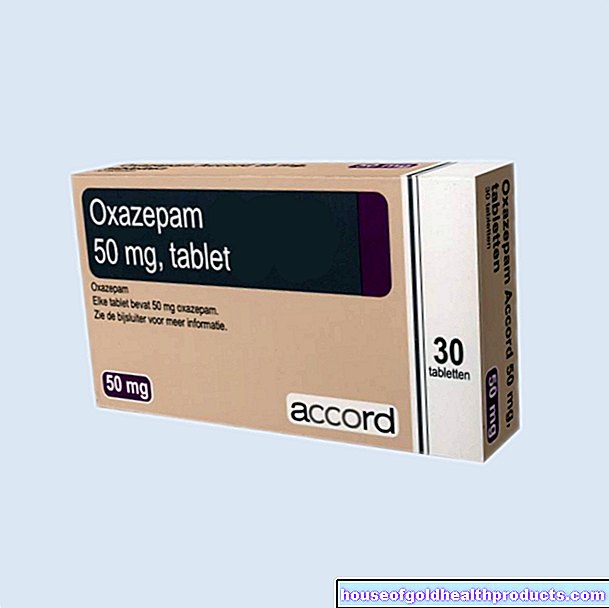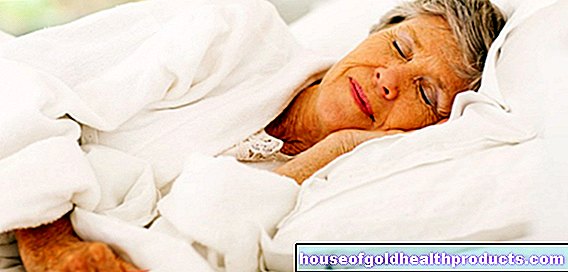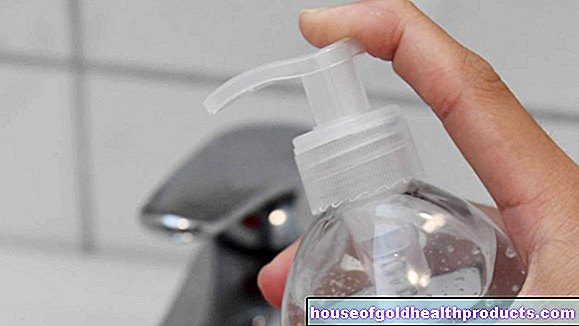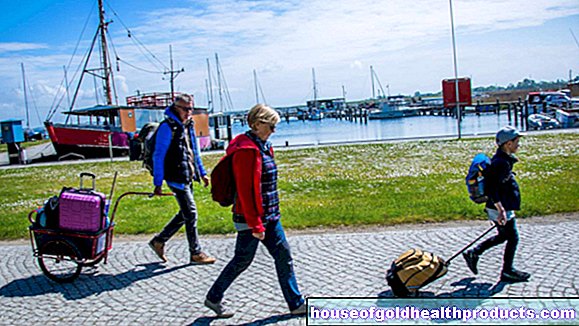Inflammation of the nail bed
Sophie Matzik is a freelance writer for the medical team.
More about the experts All content is checked by medical journalists.Inflammation of the nail bed is inflammation of the skin under the nail. It can also spread to the nail wall. Redness, itching, and pain are common symptoms of acute nail bed inflammation - and pus that builds up under the nail. Read more on the topic: How do you recognize a nail bed inflammation? What can be done against the inflammation? What are the chances of recovery?
ICD codes for this disease: ICD codes are internationally recognized codes for medical diagnoses. They can be found, for example, in doctor's letters or on certificates of incapacity for work. L03
Inflammation of the nail bed: description
An inflammation of the nail bed is a mostly bacterial infection of the nail bed. The nail bed is the tissue on which the nail plate rests - i.e. the area directly under a nail. In general, nail bed inflammation can affect toenails and fingernails equally. The infection is quite common - nail bed inflammation accounts for around 30 percent of all infections that affect the hand.
Doctors also refer to inflammation of the nail bed as onychia or panaritium subunguale (from Latin "sub" = under and "ungus" = nail). Sometimes the inflammation also spreads to the nail wall (= tissue area around the nail plate). Then it is a Panaritium parunguale - also called paronychia or "Umlauf". The last term expresses that the inflammation runs around the nail.
Acute and chronic inflammation of the nail bed
Depending on the course, a distinction is made between chronic and acute inflammation of the nail bed:
Anyone can develop acute inflammation of the nail bed - there do not have to be any special risk factors.
If the inflammation recurs despite treatment, doctors speak of chronic inflammation of the nail bed. It mostly affects people whose immune system is weakened due to a chronic disease (such as diabetes mellitus) or who repeatedly come into contact with substances that damage the skin. For therapy, it is important here that not only the nail bed inflammation is treated - the contributing factors are also addressed if possible.
Inflammation of the nail bed: symptoms
If the nail bed is acutely inflamed, this is usually first indicated by severe reddening of the affected areas of the skin. The skin around the nail becomes itchy, especially in the initial phase of the nail bed inflammation. Then the skin swells and has a reddish sheen. Local overheating is also a classic sign of inflammation.
Moderate to severe pain can be added as additional symptoms. In the beginning they only occur when there is pressure. After a few days, the affected fingers or toes also hurt without being exposed to any irritation. A doctor should be consulted at the latest when severe pain occurs without pressure stimulus.
Typically, with a panaritium subunguale, pus collects under the nail over the course of several days. This purulent swelling usually causes severe pain and can cause the nail plate to separate from the nail bed. Sometimes the pus collection bursts on its own - the pus then drains over the side edges of the nail. If the collection of pus does not open by itself, it may be necessary to open it surgically.
If nail bed inflammation is left untreated for a long time, the growth of the nail may be disturbed.
Chronic inflammation of the nail bed
An acute inflammation of the nail bed can develop into a chronic inflammation of the nail bed. This usually happens when there are other risk factors such as an ingrown toenail. A chronic inflammation of the nail bed is usually less painful than an acute one. The nail plate can be yellowish or greenish in color. Another difference to the acute form: chronic onychia usually affects several nails and not just one fingernail or toenail alone.
Inflammation of the nail bed: causes and risk factors
The most common causative agents of nail bed inflammation are bacteria of the staphylococcal type. More rarely, other bacteria or fungi or viruses (yeasts, herpes viruses) trigger the inflammation.
These pathogens do no harm to healthy skin. The pathogens can only penetrate the skin through small wounds on the nail fold, the skin or the nail wall and cause acute inflammation. The small wounds are mostly minor injuries, such as those caused by nail care. Ingrown nails and intense skin irritation (e.g. from cleaning agents) can also create entry points for pathogens.
Acute nail bed inflammation mostly affects women who practice excessive or incorrect nail care. People with dry skin are also more likely to have nail bed inflammation. People with chronic neurodermatitis or diabetes mellitus and people with circulatory disorders are also at risk. Other risk groups are people with a weakened immune system and cancer patients who are receiving therapy with so-called EGFR agonists or tyrokinase inhibitors.
Inflammation of the nail bed: examinations and diagnosis
You don't have to go to the doctor right away with every inflammation of the nail bed! With a healthy immune system and no other illnesses, you can wait a few days - the inflammation often heals on its own. However, you should see a doctor at the latest if there is no improvement within three days or the symptoms worsen rapidly. People who are known to have a weakened immune system should consult a doctor if there are any small signs of inflammation.
The right contact for a (suspected) nail bed inflammation is the family doctor or a dermatologist (dermatologist).
anamnese
In an initial conversation, the doctor will collect your medical history (anamnesis). For this he will let you describe the type and course of your complaints in detail. He can also ask the following questions, for example:
- Do you suffer from such complaints more often?
- What do you do for a living?
- Do you have any known allergies?
- Do you have any pre-existing conditions (such as diabetes)?
Investigations
The anamnesis is followed by a physical examination. The doctor examines the affected areas of skin in detail. By palpation, he determines whether there is pain. Usually the obvious symptoms of nail bed inflammation are enough to make an initial diagnosis.
In order to confirm the diagnosis and to differentiate the skin changes from squamous cell carcinoma (form of skin cancer), for example, the doctor takes a smear from the inflamed areas of the skin. In this way, under the microscope it can be seen which form of pathogen is responsible for the infection (such as bacteria, fungi). In order to determine the exact pathogen, a culture of the smear can be created in the laboratory. The evaluation of such a culture, however, takes one to several weeks.
Inflammation of the nail bed: treatment
Depending on the stage of the nail bed inflammation, the treatment can be carried out by the patient himself or by a doctor. In the early stages of the inflammation (signs of inflammation for less than three days), you can try treating nail bed inflammation yourself. However, if there is no improvement, medical treatment is necessary. It is advisable from the beginning if you have risk factors for a difficult course (e.g. immune deficiency).
Treat nail bed inflammation yourself
There are several ways to treat inflammation of the nail bed yourself. First of all, you should bathe the affected foot or finger in warm water several times a day. This will soften the cornea and make it easier for the accumulated pus to drain away. Additives such as chamomile support the beneficial effect.
After such a bath, you should apply a disinfectant solution. Some patients bandage their fingers or toes in such a way that they can no longer be moved at first - the immobilization supports the healing process.
Several over-the-counter medications for nail bed inflammation are available at the pharmacy. When choosing a suitable preparation, however, in many cases you have to know which pathogens are responsible for the inflammation. For example, the active ingredients naftifine and nystatin are antimycotics - they only work against fungal infections. They do not help with bacterial infections. If you do not know which pathogens are responsible for your nail bed inflammation, you should rather avoid such targeted drugs.
A drug that works against germs on the skin in general is burn and wound gel. It contains the active ingredients benzethonium chloride, urea and polidocanol. Another remedy for several types of germs is povidone iodine. It is the most commonly used remedy for inflammation of the nail bed. Ointment, gel or cream with povidone iodine has a disinfectant effect.
You can apply ammonium bituminosulfonate - a general anti-inflammatory agent that is also effective against bacteria and fungus - on areas that fester heavily. It is available in the pharmacy as a tincture or ointment. An ointment with ammonium bituminosulfonate is also called a pull ointment. Inflammation of the nail bed and other skin inflammations and diseases can sometimes be successfully treated with it. In some cases, however, the anti-inflammatory effect of the pull ointment is too low. However, treatment methods with stronger active ingredients can only be prescribed by a doctor.
Inflammation of the nail bed: home remedies
Home remedies for nail bed inflammation are primarily natural substances such as chamomile, arnica or savoy cabbage. They have an anti-inflammatory effect. Onion extract, horseradish, and tea tree oil are also used to treat nail bed inflammation. However, all of these home remedies only provide relief for milder inflammations and cannot replace necessary medical therapy.
Medical panaritium treatment
In the initial stage of the inflammation, the doctor tries to treat the nail bed inflammation purely externally with antiseptic agents. If the inflammation is very extensive or if there is severe pain, therapy with antibiotics is also carried out. Here, active ingredients from the class of penicillins are mainly prescribed. These are particularly effective against staphylococci - the main cause of inflammation of the nail bed.
If the nail bed inflammation does not subside after several weeks, an X-ray is used to determine whether the inflammation has already spread to surrounding structures.
Surgical intervention may be advisable if the nail bed is inflamed over a large area or if there is a stubborn accumulation of pus. The doctor removes the accumulation of pus or severely affected tissue under local anesthesia. After the procedure, the affected hand or foot is immobilized. Depending on the size of the surgical procedure, it can take one to several weeks for the wound to heal completely.
Chronic inflammation of the nail bed
In the case of chronic inflammation of the nail bed, which shows no improvement despite repeated therapy, the doctor will try to determine the triggering factors. If the recurring inflammation of the nail bed is caused by a chronic disease, this must be treated primarily. In cases where frequent handling of harsh substances or cleaning agents causes panaritium subunguale (or parunguale), these risk factors must be eliminated.
Inflammation of the nail bed: course and prognosis
The course of the disease and prognosis of the onychia or paronychia depend on the severity of the infection and the time at which treatment is started. If an inflamed nail bed is not treated, the inflammation may spread further and further. It can also spread from the skin to the tendon sheaths that surround the finger or toe joints, and from there even to the bones. Inflammation of the tendon sheaths (tendovaginitis) or bones (osteomyelitis) is very painful and often requires a long treatment.
If nail bed inflammation is treated properly, it usually heals completely within a few days. It is important to ensure that there are no irritants on the inflamed skin.
Inflammation of the nail bed: prevention
The main way to prevent inflammation of the nail bed is by taking good care of your nails. If the skin around the nail bed is dry and cracked, you should use a fatty cream and also regularly apply cream to the nails.
Do not cut the edges of the toenail round as this will encourage the nail to grow in. When caring for your nails, be careful not to damage the surrounding skin. If you have very soft and brittle nails, you may be able to strengthen your nails with magnesium and folic acid tablets - ask your doctor or pharmacist for advice.
If the nails are exposed to heavy loads in everyday life, you should ensure appropriate protection. For example, wear gloves if you often come into contact with harsh substances or strong cleaning agents. To protect your toenails, you should only wear shoes that give your feet enough space and sweat as little as possible. These measures reduce the risk of inflammation of the nail bed.
Tags: unfulfilled wish to have children tcm pregnancy birth


